By Brooke Fisher
Photos by Dennis Wise and Olivia Hagen/ University of Washington
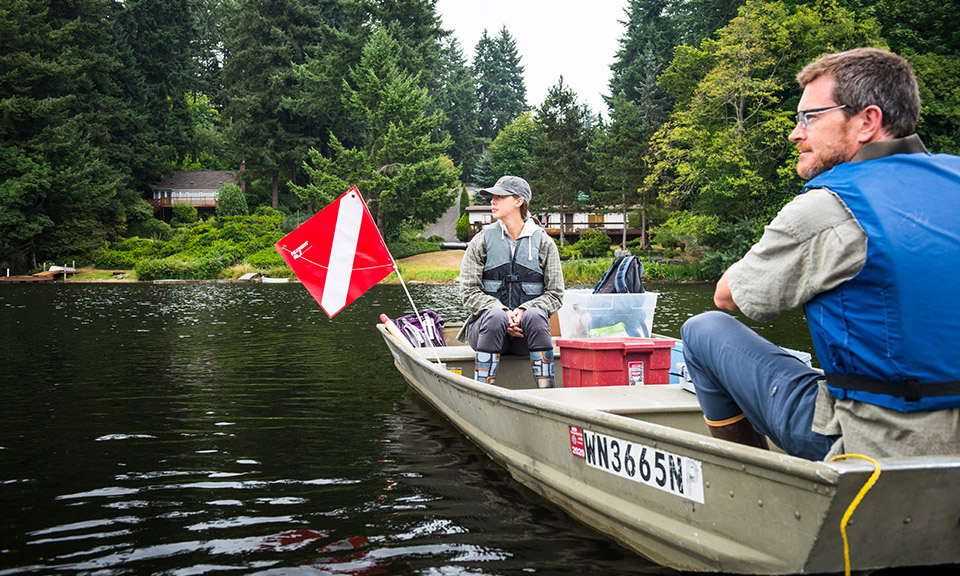
A red safety flag alerts other boats in the area that someone is in the water as professor Alex Horner-Devine and graduate student Samantha Fung watch a diver from the EPA collect an instrument used to measure water velocities.
CEE researchers investigate surprising arsenic discoveries
Several times per month, civil and environmental engineering graduate student Samantha Fung heads to Lake Killarney, a shallow lake surrounded by greenery and lakeside homes in Federal Way. Unlike many who frequent the lake, she isn’t there for recreation.
Fung is there to learn more about surprising arsenic-related discoveries that UW researchers have uncovered during the past few years.
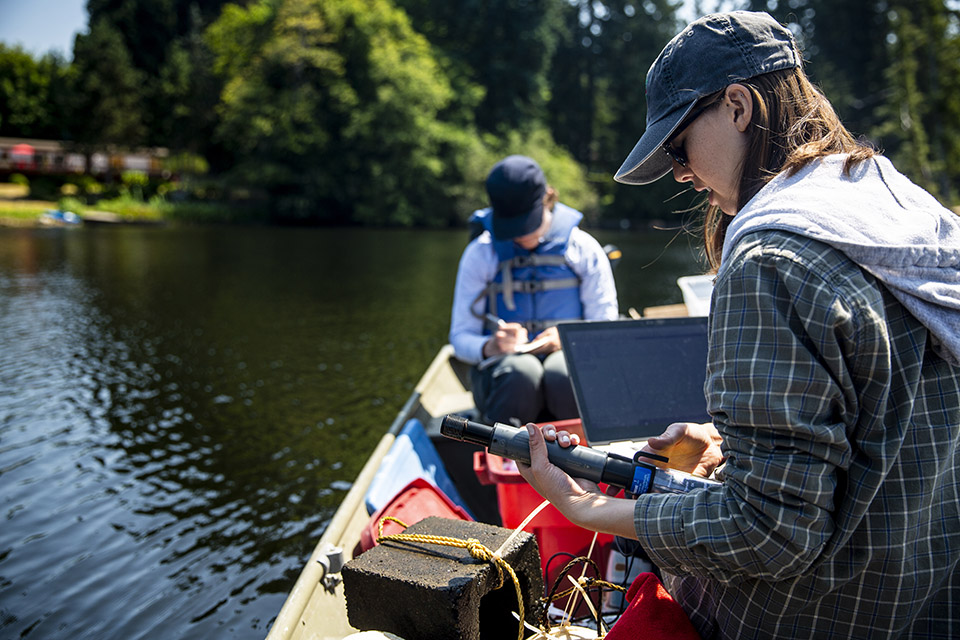
Graduate student Samantha Fung offloads data from the dissolved oxygen probe to the field computer for future analysis.
“It’s very rare to study a lake as small as Lake Killarney,” says Fung, who has worked on the research project for close to two years. “This project is aimed at determining which lakes are most susceptible to contaminants and have a higher chance of arsenic being transferred up the food web.”
Arsenic in Food, Water, Plants and Animals
Learn more about arsenic in our ecosystem from CEE associate professor Rebecca Neumann, an arsenic expert who is advancing knowledge of how arsenic in our global and local environment affects food and water quality and the health of ecosystems.
Located about 15 miles from the former American Smelting and Refining Company (ASARCO) copper smelter near Tacoma, Lake Killarney is one of several lakes that has arsenic-contaminated sediments. For 96 years, the copper smelter pumped waste byproducts in the form of arsenic and lead out of a tall smokestack, which were scattered downwind.
Although the copper smelter hasn’t been operational for more than 30 years, legacy sediment contamination serves as a long-term source of toxicity to the ecosystem. While the hazards of dirt contamination in the area are more widely known, thanks to a Dirt Alert program issued by the Department of Ecology that encourages homeowners to get their soil tested for free, the water-related hazards have been largely overlooked until now.
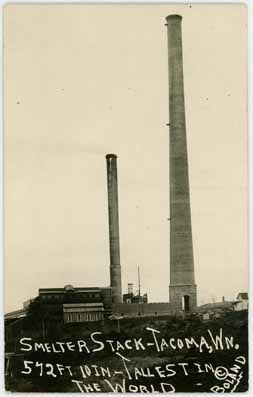
A historical photo of the 572-foot smokestack of the ASARCO Smelter in Tacoma, Wash. A shorter smokestack and buildings are adjacent to it.
Photo credit: 2008.147.1, Washington State Historical Society, Tacoma (Wash.)
After a surprising discovery that some shallow lakes, such as Lake Killarney, have unique characteristics that facilitate the movement of arsenic from lakebed sediment up into the food web, a team of UW researchers is working to further investigate the movement of water and impact on aquatic life.
Leading the project, which is supported by UW’s Superfund Research program, are CEE associate professor Rebecca Neumann and environmental chemistry and engineering associate professor at UW Tacoma Jim Gawel, in collaboration with CEE professor Alexander Horner-Divine and school of aquatic and fisheries science professor Julian Olden. The researchers hope their findings will improve future arsenic water-quality guidelines, as well as help prioritize which lakes are in urgent need of remediation.
“Arsenic fortunately doesn’t pose much of a contact risk, but the biggest concern is ingestion of arsenic,” Neumann says. “A possible exposure pathway is people eating snails, crayfish or fish, which may have high levels of arsenic.”
A surprise finding: arsenic in shallow lakes
For the past four years, the researchers have been investigating lakes in the Tacoma vicinity, with a special focus on Lake Killarney and Angle Lake. Although both are small lakes located in urban settings, they have very different depths – Angle Lake is about four times as deep as Lake Killarney.
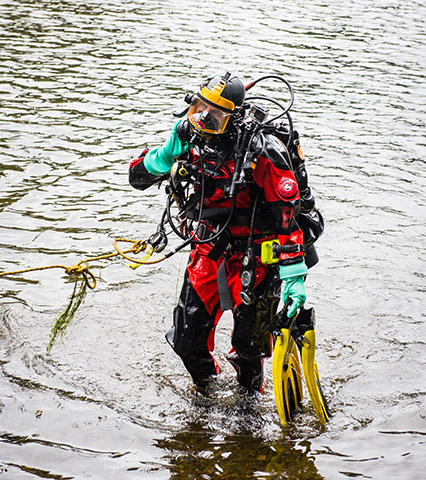
EPA divers help deploy instruments to the bottom of the lake to measure water velocity at Lake Killarney.
While both lakes have similar levels of arsenic contamination in their lakebed sediment, the UW researchers were surprised to discover that the arsenic in the shallow lake had traveled up into oxygenated surface waters where the aquatic food web resides, while the arsenic in the deeper lake remained trapped in bottom waters devoid of oxygen and aquatic life.
“We were seeing higher concentrations of arsenic up throughout the water column and dramatically more arsenic in plankton, which is the base of the food web,” says Neumann about the shallow lake.
Plankton in the shallow lake accumulated up to 10 times more arsenic, which becomes chemically similar to phosphate in oxygenated water. Plankton mistakenly consume it, assuming it is the phosphate that fuels their growth. The arsenic then continues to travel up the aquatic food web, as plankton are consumed by zooplankton, which are then consumed by small crustaceans and fish.
Shallow lake mixing
To determine why arsenic travels from the lakebed sediment up into the aquatic food web in some lakes, but not in others, the researchers are currently working to better understand the hydrodynamics, or movement of water, within Lake Killarney.
Lakes typically form stratified layers, where warmer water settles on top of heavier, colder water. In deeper lakes, such as Angle Lake, the two layers do not mix for extended periods of time. During these long periods of stratification, the colder water on the bottom often becomes oxygen-depleted. The oxygen-depletion causes arsenic to be released from the sediments and also causes the bottom of the lake to be uninhabitable for aquatic life. Thus, there is extremely limited overlap between areas where aquatic life live and areas that are contaminated, which limits the potential for animals to intake arsenic.
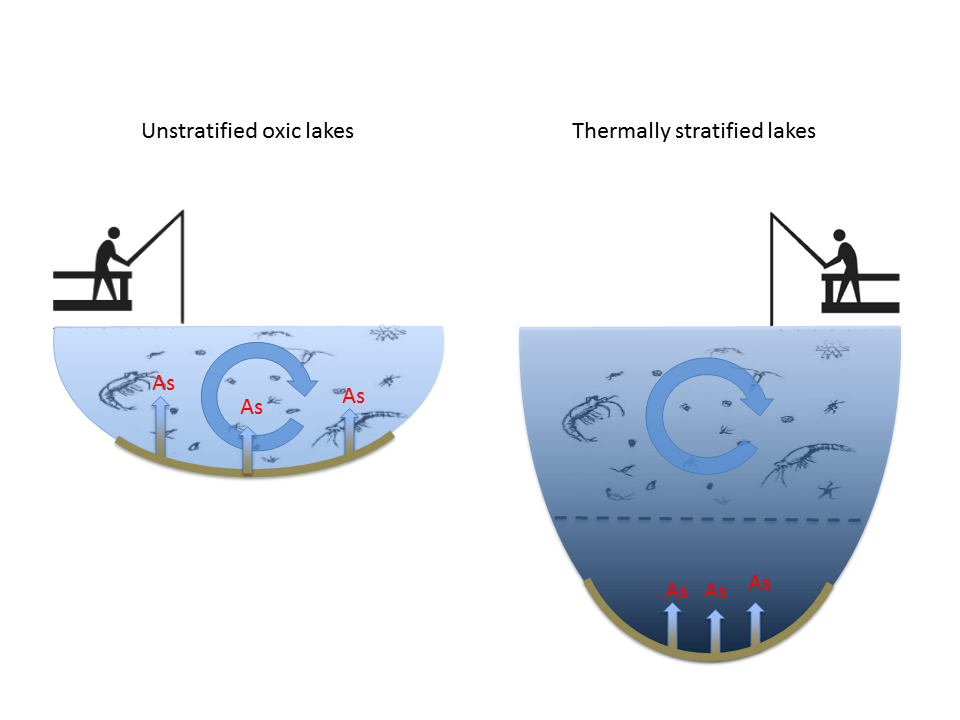
Lake mixing impacts how much arsenic is transferred from sediments to the top of the water column. Comparison of a weakly stratified lake, left, and a stratified lake, right, where arsenic remains trapped in bottom waters.
In a very shallow lake, such as Lake Killarney, however, the layers can be mixed much more easily. In the summer, a daily cycle has been identified by researchers whereby the lake develops layers during the hot afternoons, but mixes fully during the night when the surface water cools and becomes heavy enough to sink and cause mixing. Arsenic that is released from the sediments during the afternoon then has the potential to be mixed into the rest of the lake, where fish and other organisms live.
“When the water column fully mixes, we expect to see arsenic move up toward the top of the water column, a phenomenon we observe in our preliminary data,” Fung says. “It really matters how the lake water is mixed, which determines how much the arsenic is a danger to the animals in the lake.”
When compared to deep lakes, the researchers also found a 10-degree temperature difference in the water directly above the lakebed sediment in shallow lakes. Their hypothesis, therefore, is that warmer water that comes into contact with the lakebed sediment fuels microbial activity, leading to arsenic being released from the sediment. The researchers published a paper about arsenic in shallow lakes in Science of the Total Environment in May 2018.
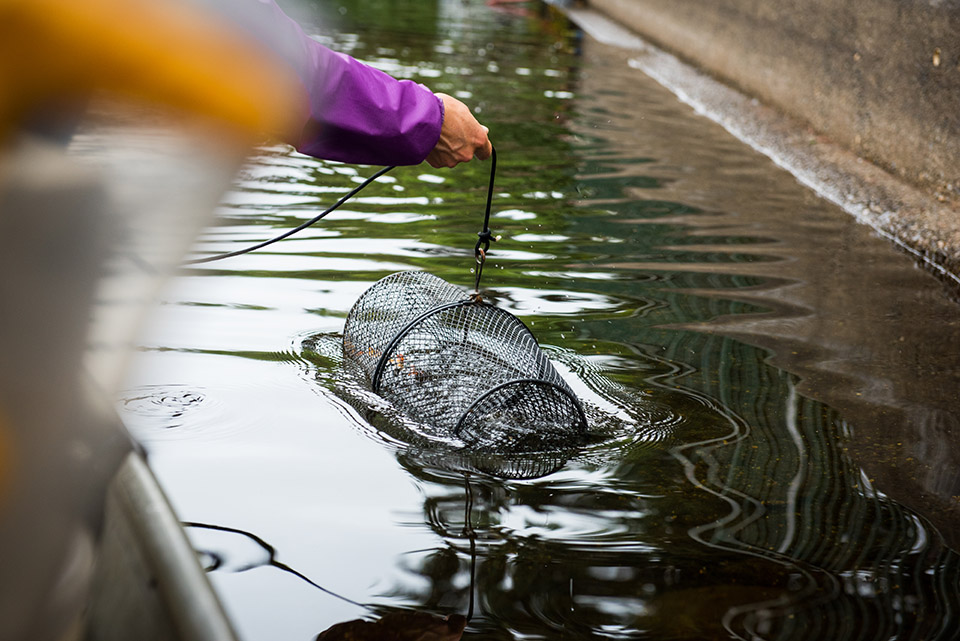
Setting crayfish traps in Lake Killarney.

A researcher places bait in a crayfish trap.
Impact on the aquatic food web
To determine how the arsenic is impacting the health of the aquatic ecosystem, the researchers are tracking the movement of the contaminant into various aquatic organisms. To do so, they are analyzing fish, crayfish and snails, as well as algae, which is consumed by a variety of aquatic life and contains a significant amount of arsenic.
The researchers are also working to identify measurable indicators, called biomarkers, that can help pinpoint how aquatic life is affected by arsenic toxicity. This could one day make it easier to identify aquatic organisms that are under stress from heavy metal toxins.
“Ultimately our plan is to look for the biomarkers within the fish and overlap that with our biogeochemical and hydrodynamic information,” says Neumann. “This will give us a good idea of the characteristics of a lake system that make it susceptible to contamination and the indicators within organisms that let us know if they are experiencing toxicity.”
The researchers have found that the concentration of arsenic in the upper oxygen-rich water, rather than the concentration in the sediment, predicts how much arsenic will accumulate in the food web, a process known as bioaccumulation. Aquatic life reside in oxygen-rich waters and therefore have the ability to intake arsenic when it is mixed up from the sediment into the inhabitable upper waters.

Associate professor Rebecca Neumann and graduate student Samantha Fung inspect the quality of offloaded data.
Informing water quality guidelines
The Federal Water Pollution Control Act requires all states to adopt surface water quality standards for lakes, streams and rivers. Currently, arsenic concentrations in water are either deemed above or below a set threshold.
To better assess the impact of heavy metal contamination, the guidelines should take into account other factors such as whether the arsenic is found in oxygenated water and the bioaccumulation of arsenic in aquatic life, according to Neumann.
“Water quality guidelines are not always indicative of harm to the ecosystem,” Neumann says. “Without context and information about the system, arsenic concentration doesn’t predict bioaccumulation. So the end goal is to go into a system and identify ecosystems that are experiencing metal toxicity.”
Remediation recommendations
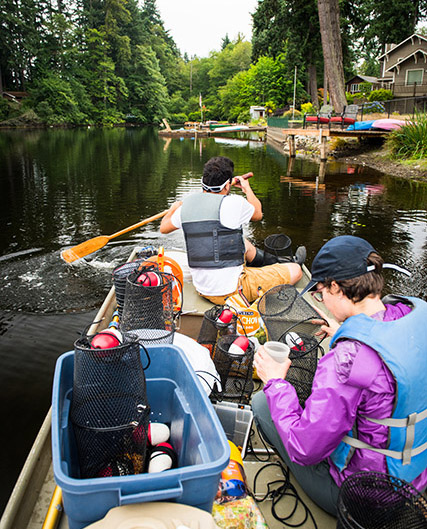
Associate professor Rebecca Neumann and field technician Marco Barajas set out crayfish traps as part of an experiment testing arsenic accumulation in different parts of the food chain.
Efforts to clean up contaminated soil throughout the Tacoma vicinity continue to this day in areas such as Commencement Bay, Ruston and north Tacoma.
The area was deemed an Environmental Protection Agency (EPA) Superfund clean-up site in the early 1980s; the program helps to clean up abandoned hazardous waste sites.
In the 1990s, with EPA oversight, ASARCO was required to replace soil at about 2,400 properties. With widespread contamination throughout the area, it is important to know where to focus future funding and remediation efforts, Fung says.
“This is why the findings from Lake Killarney versus Angle Lake are important. If we only had money to clean up one lake, we would want to focus on Lake Killarney,” Fung says.
Originally published October 16, 2019